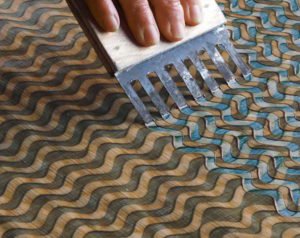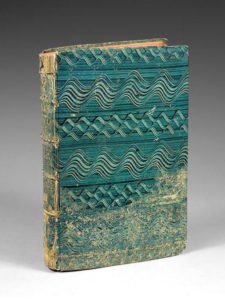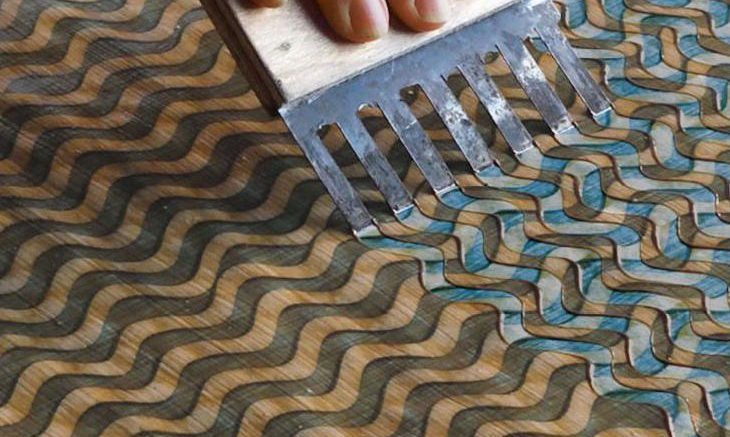
Marking with a tool. Provided photo.
The Newark Valley Historical Society will sponsor a Paste Paper workshop with local artist and teacher Sue Camin on April 14. The workshop will take place from 10 a.m. to 3 p.m. at Bement Billings Farmstead Museum, located on Route 38 in Newark Valley.
All materials for the workshop will be provided. The cost is $25 for Newark Valley Historical Society members, and $30 for non-members. Register by March 28 by calling 642-5412.
Paste Paper is the first of three workshops featured in the Paper Series, which also includes Coptic Book Binding on April 21 and Nature Sketching on May 5. Although all three workshops projects are related, each may be enjoyed and registered for separately.
The use of paste paper designs on book covers and inside pages has been in practice since as early as the17th century. It is one of the oldest decorated papers used by bookbinders, and can be found in books that are centuries old.

An 18th century book; paste paper cover. Provided photo.
Fast forward, in recent years paste papers have had a resurgence among contemporary artists using the techniques to create a variety of additional art forms in an endless variety of applications, including decorative covering for boxes, frames, journals, cards and stationery.
Going back hundreds of years (and continuing today), sometimes bookbinders would use up their leftover bookbinding paste by throwing some pigment into the paste and brushing it out on some paper to make decorative papers to then use in bookbinding. They would make strokes or stipple patterns with a brush in the paste, or use tools to draw or comb designs in the paper and let it dry.
One of the distinctive qualities of paste paper is the rich 3-dimensional patterns and designs. This is achieved because when the paste is first applied to the paper and a pattern made in the paste, it is thick, with peaks and valleys. As the paper dries, the paste is sucked flat into the paper, leaving a 3-dimensional pattern on a 2-dimensional surface.
If you or someone you know is a collector of old books, no doubt you will be pleasantly surprised to see the beautiful patterns of swirled designs on the cover of a book or as end papers inside a book. Your local used bookstore will be a treasure trove of examples.
Paste paper became popular here in North America during the 18th and19th century. Please note the provided photos showing paste paper used on an 18th century book cover plus the bright contemporary colors used in other photos.
Eric Carle, author and illustrator, created paste paper designs on tissue paper. His highly colorful patterned papers were used to create The Very Hungry Caterpillar and more.
Other artists and illustrators are finding the beauty of their handmade papers go beyond traditional books and are creating collaged art works of all kinds – both two and three dimensional.
Guests are invited to come and enjoy the adventure and creativity of making paste paper. Using cornstarch paste and acrylics, learn how to create simple or complicated designs using everyday tools around the house. Soon you will see that this age old art is easy and exciting and opens so many new possibilities for adults and children of all ages.
Be sure to register by March 28 by calling Leslie at 642-5412.
For workshop details, visit nvhistory.org.



Be the first to comment on "The Art and History of Paste Paper Making at Bement Billings Farmstead"